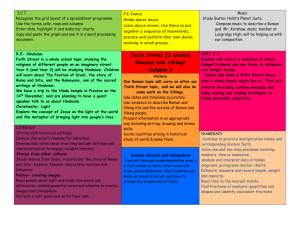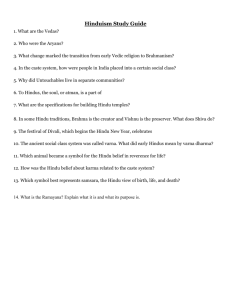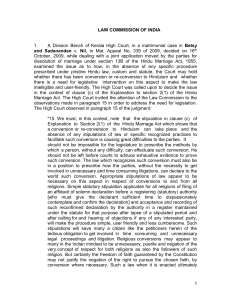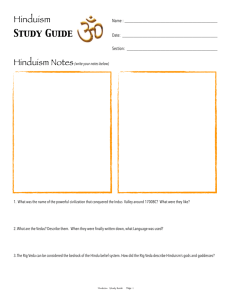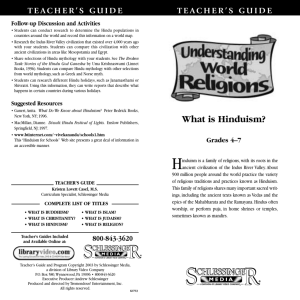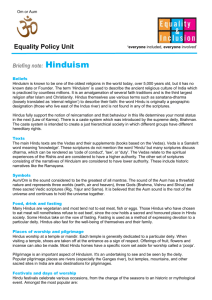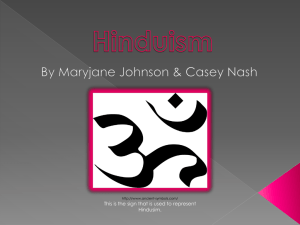Hinduism
advertisement
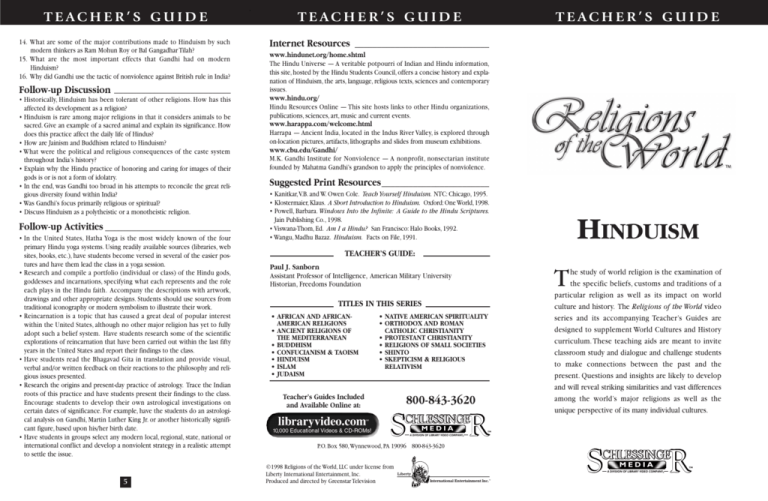
TEACHER’S GUIDE TEACHER’S GUIDE 14. What are some of the major contributions made to Hinduism by such modern thinkers as Ram Mohun Roy or Bal Gangadhar Tilah? 15. What are the most important effects that Gandhi had on modern Hinduism? 16. Why did Gandhi use the tactic of nonviolence against British rule in India? Internet Resources ______________________________ Follow-up Discussion __________________________ • Historically, Hinduism has been tolerant of other religions. How has this affected its development as a religion? • Hinduism is rare among major religions in that it considers animals to be sacred. Give an example of a sacred animal and explain its significance. How does this practice affect the daily life of Hindus? • How are Jainism and Buddhism related to Hinduism? • What were the political and religious consequences of the caste system throughout India’s history? • Explain why the Hindu practice of honoring and caring for images of their gods is or is not a form of idolatry. • In the end, was Gandhi too broad in his attempts to reconcile the great religious diversity found within India? • Was Gandhi’s focus primarily religious or spiritual? • Discuss Hinduism as a polytheistic or a monotheistic religion. Follow-up Activities ____________________________ • In the United States, Hatha Yoga is the most widely known of the four primary Hindu yoga systems. Using readily available sources (libraries, web sites, books, etc.), have students become versed in several of the easier postures and have them lead the class in a yoga session. • Research and compile a portfolio (individual or class) of the Hindu gods, goddesses and incarnations, specifying what each represents and the role each plays in the Hindu faith. Accompany the descriptions with artwork, drawings and other appropriate designs. Students should use sources from traditional iconography or modern symbolism to illustrate their work. • Reincarnation is a topic that has caused a great deal of popular interest within the United States, although no other major religion has yet to fully adopt such a belief system. Have students research some of the scientific explorations of reincarnation that have been carried out within the last fifty years in the United States and report their findings to the class. • Have students read the Bhagavad Gita in translation and provide visual, verbal and/or written feedback on their reactions to the philosophy and religious issues presented. • Research the origins and present-day practice of astrology. Trace the Indian roots of this practice and have students present their findings to the class. Encourage students to develop their own astrological investigations on certain dates of significance. For example, have the students do an astrological analysis on Gandhi, Martin Luther King Jr. or another historically significant figure, based upon his/her birth date. • Have students in groups select any modern local, regional, state, national or international conflict and develop a nonviolent strategy in a realistic attempt to settle the issue. 5 TEACHER’S GUIDE www.hindunet.org/home.shtml The Hindu Universe — A veritable potpourri of Indian and Hindu information, this site, hosted by the Hindu Students Council, offers a concise history and explanation of Hinduism, the arts, language, religious texts, sciences and contemporary issues. www.hindu.org/ Hindu Resources Online — This site hosts links to other Hindu organizations, publications, sciences, art, music and current events. www.harappa.com/welcome.html Harrapa — Ancient India, located in the Indus River Valley, is explored through on-location pictures, artifacts, lithographs and slides from museum exhibitions. www.cbu.edu/Gandhi/ M.K. Gandhi Institute for Nonviolence — A nonprofit, nonsectarian institute founded by Mahatma Gandhi’s grandson to apply the principles of nonviolence. Suggested Print Resources________________________ • Kanitkar,V.B. and W. Owen Cole. Teach Yourself Hinduism. NTC: Chicago, 1995. • Klostermaier, Klaus. A Short Introduction to Hinduism. Oxford: One World, 1998. • Powell, Barbara. Windows Into the Infinite: A Guide to the Hindu Scriptures. Jain Publishing Co., 1998. • Viswana-Thom, Ed. Am I a Hindu? San Francisco: Halo Books, 1992. • Wangu, Madhu Bazaz. Hinduism. Facts on File, 1991. HINDUISM TEACHER’S GUIDE: Paul J. Sanborn Assistant Professor of Intelligence, American Military University Historian, Freedoms Foundation TITLES IN THIS SERIES • AFRICAN AND AFRICANAMERICAN RELIGIONS • ANCIENT RELIGIONS OF THE MEDITERRANEAN • BUDDHISM • CONFUCIANISM & TAOISM • HINDUISM • ISLAM • JUDAISM • NATIVE AMERICAN SPIRITUALITY • ORTHODOX AND ROMAN CATHOLIC CHRISTIANITY • PROTESTANT CHRISTIANITY • RELIGIONS OF SMALL SOCIETIES • SHINTO • SKEPTICISM & RELIGIOUS RELATIVISM Teacher’s Guides Included and Available Online at: 800-843-3620 S R CHLESSINGE MEDIA A DIVISION OF LIBRARY VIDEO COMPANY® TM P.O. Box 580,Wynnewood, PA 19096 800-843-3620 ©1998 Religions of the World, LLC under license from Liberty International Entertainment, Inc. Produced and directed by Greenstar Television he study of world religion is the examination of the specific beliefs, customs and traditions of a particular religion as well as its impact on world culture and history. The Religions of the World video series and its accompanying Teacher’s Guides are designed to supplement World Cultures and History curriculum. These teaching aids are meant to invite classroom study and dialogue and challenge students to make connections between the past and the present. Questions and insights are likely to develop and will reveal striking similarities and vast differences among the world’s major religions as well as the unique perspective of its many individual cultures. T Liberty International Entertainment Inc.™ S R CHLESSINGE MEDIA A DIVISION OF LIBRARY VIDEO COMPANY® TM Historical Overview ______________________________ Atman — The Hindu concept of the individual self or soul. Mahabharata — The epic poem that tells of two feuding royal families who descend from a common ruler named Bharat and suffer through the horrors of a long civil war. Bhagavad Gita — The 18th chapter of the Mahabhrata and part of the Hindu sacred scriptures. Literally the words mean “Song of God.” It is an extended discourse on Hindu metaphysics between the warrior Arjuna and the Hindu god Krishna (Vishnu). Dharmashastras — Books of law detailing the stages of a man’s life and how each man should behave in passing through each stage. In general, there are four stages: the student, the householder, the seeker and the ascetic. Kama Sutra — The Hindu text that serves as a guide for mature sexuality. Ramlila — The festival to celebrate the god Rama, whose most famous experience is highlighted in the Ramayana. The story of the Ramayana is re-enacted during this holiday. Ahimsa — The Hindu ideal of complete nonviolence in thought, word and deed. This belief is the foundation of Gandhi’s resistance philosophy against the British. The concept was originally borrowed from Jainism. Satyagraha — Sanskrit for “holding to the truth.” This term was used by Gandhi to describe the religious and political tactics that he used against the British in India. Mahatma — Title given to Gandhi meaning “Great Soul.” Puja — The act of worship during which incense is burned and offerings are made to a Hindu deity represented by a statue or picture. Yoga — The practice used to gain control over the mind and body in order to (Continued) reflect on the path to enlightenment. Lotus Position — A sitting position in which legs are crossed over and bent in on themselves so that the heel of each foot is placed on top of the opposite thigh. This position encourages breathing and physical discipline conducive to deep meditation. Sanskrit — The Hindu language, originating in 1500 B.C.E., in which the sacred scriptures are written. Veda — From Sanskrit, meaning “truth” or “knowledge.” This word is applied to the ancient Hindu scriptures. Samhitas — The earliest portions of the Vedic library of scriptures and spiritual principles accepted by Hindus as the foundation of their faith. Rishis — Inspired sages who heard the hymns of the gods and transcribed them into the Vedas. Mantra — A sacred, special incantation or prayer. Indra — One of the most popular Vedic gods, resembling Zeus of Greek mythology. Vedic Age — The period between 1500 and 1200 B.C.E. in which the Vedas are written and compiled. Brahmanas — Vedic writings added to the Hindu scriptures between 1000 and 800 B.C.E. The Brahmanas explain many ceremonies and priestly duties discussed in the earlier Vedas. Upanishads — The final writings added to the Vedic scriptures sometime between 800 and 300 B.C.E. Upanishads means “sitting near” or “at the feet of a master” in Sanskrit. They are direct accounts written by spiritually advanced mystics concerning advice on new developments within the Hindu faith, such as the belief in reincarnation. They represent the final phase in the development of the Vedas. Samsara — The Sanskrit term for reincarnation, a worldly cycle of birth, death and rebirth until a soul achieves enlightenment and embraces the sacred reality of the Absolute. Caste System — The Hindu social system of dividing people into a rigid class structure. Men have the least mobility between castes. Women may change their original or birth caste through marriage. The four major castes are the Brahmins (priests), the Kshatriyas (warriors and rulers), the Vaishyas (merchants and farmers) and the Shudras (laborers). The Untouchables are outside of the caste system and are believed to contaminate anything or anyone with whom they come in contact. Jainism and Buddhism — Two protest religions that formed as reactions against selected Hindu religious practices and/or teachings such as the power of the priests, the overwhelming presence of rituals and the alienation of the lower castes from their Hindu faith. Karma — An impartial force or principle of cause and effect that accounts for each person’s good and bad actions and determines their position of rebirth based upon each person’s actions in their previous lifetime. Brahma — The world spirit, the Absolute, the chief god of the Hindu faith who is associated with the creation of all reality. Union with Brahma is seen as the end goal for all individuals seeking enlightenment within Hinduism. Brahman — The One, Absolute God to which all other gods are lower. Vishnu — The preserver god representing divine love who has been incarnated as Krishna and Rama. Shiva — The energy force of the Absolute, who is seen as the great cosmic (Continued) creator and destroyer. 2 3 4 Nearly four thousand years old, Hinduism is truly one of the oldest living religions on Earth. It is a fascinating faith with countless sects and practices but no identified founder and no specific formal doctrine. Hinduism and some of its spiritual and meditative exercises, such as yoga and transcendental meditation, are actively practiced by over one billion people around the globe. Not only has Hinduism influenced other major religions, such as Buddhism, Jainism and the Sikh tradition, but it has also had a powerful effect on culture and daily life worldwide. Time Line ______________________________________ 2500–1500 B.C.E. — The Indus River Valley civilization develops and flourishes. Evidence of early Hindu practice is archaeologically dated to this vanished culture. 1600–1400 B.C.E. — The Aryan warrior culture conquers the Indus River Valley, bringing with it the Sanskrit language and major influences in the development of Hinduism. 1500–1200 B.C.E. — The Vedic Age in which the Rig Veda is written, reflecting the influence of joining the Aryan and Indus River Valley cultures. 1000–300 B.C.E. — The Brahmanas and Upanishads are written and added to the original Vedas. 600–500 B.C.E. — The Age of Protest as Buddhism and Jainism break away from the main flow of Hinduism. 400 B.C.E.–800 C.E. — The Hindu response to Buddhism and Jainism results in further changes to the main teachings of Hinduism. 326 B.C.E. — Alexander the Great brings his army and the influence of Greek civilization into the northernmost regions of India. The Indian Mauryan Empire is created to counter this Greek invasion of culture and ideas. 250 B.C.E. — Ashoka becomes Emperor of the Mauryan Dynasty. 400–500 C.E. — Hinduism returns as the dominant religion of India. Temples and monuments are built to honor Hindu ideas, gods and beliefs. This is the era of the Hindu Renaissance. 800–1000 C.E. — Bhakti movements begin to develop in India. 900 C.E. — Shankara teaches the reality of One Brahman or One God, introducing significant monotheistic beliefs into Hinduism. 1100 C.E. — Muslims arrive in India and influence the evolution of the Hindu faith. 1400–1700 C.E. — Europeans arrive in India to pursue colonization and commercial goals within the Hindu world. 1919–1948 C.E. — The era of Mahatma Gandhi’s profound influence on Hinduism and India. 1948–1990 C.E. — India and Pakistan become independent countries and enter the modern era. Both possess nuclear weapons and suffer from religious tension among their Muslim and Hindu populations. Vocabulary ______________________________________ Pre-viewing Discussion ________________________ • Discuss Gandhi and what students may already know of his role in India’s history and his belief in the principles of nonviolence. Speculate about how this might relate to Hindu practices and beliefs. • Using a world map, have students highlight the areas of the world in which one might expect to find Hinduism as the predominant faith. • Develop with the class a list of terms and concepts associated with Hinduism that the students already know and are able to explain. Focus Questions ______________________________ 1. 2. 3. 4. 5. 6. Explain at least two ways a typical Hindu might begin his/her religious day. What are the Vedas? What role do they play in Hinduism today? What is reincarnation? What were Buddhism and Jainism reacting against within the Hindu faith? What is the caste system? In the period from 500 B.C.E. to 800 C.E., how did the Hindus deal with the challenges of the Buddhists and the Jains? 7. Who is Shankara and what is significant about his teachings? Is his position one that is commonly accepted by most Hindus today? 8. What important Hindu lesson does the warrior Arjuna learn from the god Krishna in the Bhagavad Gita? 9. What are the Hindu stages of life that a man should expect to pass through in his lifetime in the pursuit of spiritual fulfillment? 10. What is the role of astrology in Hinduism? 11. What is the significance of the Ganges River in Hinduism? 12. Which day of the week is traditionally considered the Hindu Sabbath? 13. Where did the term “Hinduism” originate and when? (Continued)
